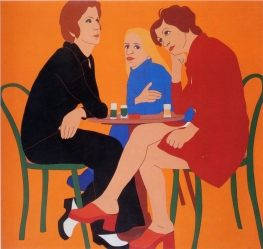
Para o estudo da melancolia em Portugal - Retrato dos críticos, 1971. Colecção Brasileira do Chiado
MNAC
entry: General ConditionsRetrospective of Portraits 1955-1974
Nikias Skapinakis
1996-04-30
1996-06-30
Curatorship: Nikias Skapinakis, Raquel Henriques da SIlva, Pedro Lapa
The portrait, as a pictorial genre, has provided sonic of the greatest moments of Portuguese painting. The unique and hopeful panorama of the faces in the St. Vincent polyptych, the symbolic illumination of King John II holding the sword of justice, the supposed wedding of King Manuel, the closed face of King John III faced with the courtly and haughty counterpoint of Queen Catherine, the lost and dreamy gaze of King Sebastian by Cristóvão de Morais, are all moments which transcend mere physionondcal registering and become involved within the greater dynamics of universal adventure.
Then, the intimate and doleful register of a country more mid more on the edge, marked out by the specific singularity of habits and customs, would be masterfully shown by the talent of painters who are today unknown or almost forgotten, and the human element seemed to superimpose itself over the cold rhetoric of power. The portrait of Queen Catherine as a child is touching, fragile within the austere and dark framing of the garments, or that of her brother, the unfortunate King Afonso VI, playing with the little black boy. The casmopolitan breath of the baroque was unable to check the delicateness of the sentiment, and even in the great state portraits of King John V in the Coimbra Library, or of King Joseph and his wife enthroned and surrounded by allegories, there transpire, beneath the cold academia of the poses and attitudes, the subtleties of the human condition. This pictorial register would pass on uninterruptedly through the unhappy Queen Mary, drowned in pearls, the obese King John VI, uninspiring in his figure, through the perverse and authoritarian expression of Queen Carlota Joaquina and the fratricide counterpoint of King Peter and King Michael, radically different in their faces and attitudes. Queen Mary II, maternal and moralizing, and King Ferdinand of Sax-Coburg, with his dishevelled hair and inspired gaze, would now be the portraits In which a romantic cycle begins.
From then on, other artistic and chronological aims are drawn up, those In which the course of the Museu do Chiado is begun. Mature Romanticism shows through In the emblematic Five Artists in Sintra, simultaneously a self-portrait and portrait of a generation and time, and it is touched with aristocratic tints in the Viscountess of Menezes. Further on, the mother of Dr. Sousa Martins, goodly widow and, corrected by the naturalist view, the portrait of Abel Botelho, picturesque among oriental bric-a-brac and that of Helena Dulac, in mundane hues of satin. The fantasmatic portrait of Antero is the desperate register of a world of giving up which only Columbano could give, the deconstructed head of Santa Rita, the portrait of the futurist thrill, and the geometricised and pasted figure of Mario Eloy's self portrait, the modernist vision of a painter who closes in within himself and avoids our gaze.
Now, we finally come to the portraits by Nikias Skapinakis in the Museu do Chiado. The series begins in 1955, and goes on through almost two decades individual and group portraits, the former intimate and affective, the latter registers of social attitudes and practices. Continuing the holdings of the Museum itself, the collection of portraits by Nikias Skapinakis thus simultaneously resumes the tradition of the portrait in western art, and particularly in Portuguese painting. The resuming of these traditions is, however, corrected by the plastic modernity of the contemporary vision and by the painter's constant attention to the universe which surrounds him — and in this sense Nikias' portraits are true self-portraits. The space of the Museu do Chiado is thus opened to one of the most relevant western pictorial genres, superbly served by the great portrait artist Nikias Skapinakis.
Simonetta Luz Afonso
On Exhibition
The Ascension of Mont Ventoux
Manuel Valente Alves
2025-10-26
2026-02-16
Curatorship: Lúcia Saldanha
Photographs, drawings and paintings, by Manuel Valente Alves that develop a poetic dialogue with Petrarch's letter of the same name (Ascensus Montis Ventosi), written in 1336.
.
2025-10-16
2026-02-01
Curatorship: Susana Lourenço Marques, Emília Tavares
This exhibition, in partnership with the Porto Museum, presents the work of three amateur photographers - Margarida Relvas, Mariana Relvas and Maria da Conceição de Lemos Magalhães - developed in Portugal between 1860-1920.
Mily Possoz. A poetics of space
2025-10-01
2026-02-01
Curatorship: Emília Ferreira
The exhibition “Mily Possoz. A Poetics of Space” continues the research into the lesser-studied Portuguese modernists artists present in the collections of the MNAC and Millennium bcp.
Impressões Digitais. MNAC Collection
2024-12-12
2026-12-30
Curatorship: Ana Guimarães, Emília Ferreira, Maria de Aires Silveira e Tiago Beirão Veiga
Consisting of founding works of contemporary Portuguese art historiography, from 1850 to the present day, the MNAC's collection holds several national treasures.
Since 1911
2022-05-26
2026-05-26
An intervention that celebrates 110 years of the MNAC.










